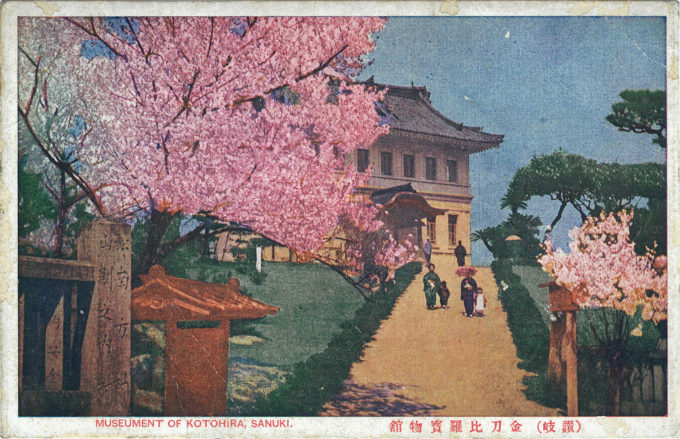See also:
Himeji Castle, c. 1920.
Kaikosha of Kudansakaue, Tokyo, c. 1910.
“The Konpiragu Shrine Treasure House, also known as the Treasure Museum, was built in 1905 based on a design by Masamichi Kurume, an engineer of the Ministry of Education. It was originally called ‘Kotohira-gu Museum No. 1’.
“Like the Nara National Museum, completed in the late Meiji period in 1894, the Treasure Museum is one of the earliest museums in Japan. Masamichi had earlier designed the Japan Pavilion for the 1893 World’s Fair in Chicago.
“The Treasure Museum is a two-storied building made of Aoki stone, a type of granite from Hiroshima. The roof is tiled with a gabled roof. The copper-sheathed gabled entrance is of an indigenous Karahafu-style design, similar in appearance to the gables of Himeji Castle, with the general building design that of the Momoyama-style. (The first concept of Tokyo Central Station by Tatsune Kingo was also of the Momoyama-style.) Upon viewing the building during a visit to Kotohira while on a long tour of Japan in 1905, it is said that Frank Lloyd Wright recognized the merit of Japanese architecture.
“There is also a stone tablet at the entrance of the museum upon which is chiseled a poem by Kobayashi Issa. Written in Japanese, the poem if often translated to say `Going to the butterfly city, arriving at Kotohira Shrine.’
“Among its many displays are the Thirty-six Immortals of Poetry and the standing statue of the Eleven-faced Kannon, an Important Cultural Property made in the Heian period from a single piece of cypress wood and stands at 14m (207 ft.) in height.
“The town of Kotohira is known as the ‘birthplace of the udon shop’ and is home to many restaurants serving Sanuki udon, Kagawa prefecture’s signature dish. The noodles are handmade and served in a light soup made from iriko dashi (anchovy stock), often topped with chopped green onions.”
– Wikipedia



Pingback: Kora Taisha Shrine (“National Shrine of the Gods”), Kurume, Fukuoka Prefecture, c. 1920. | Old Tokyo